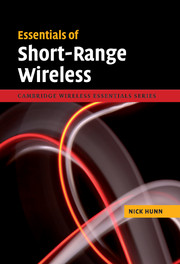Book contents
- Frontmatter
- Contents
- 1 Introduction
- 2 Fundamentals of short-range wireless
- 3 Wireless security
- 4 Bluetooth
- 5 IEEE 802.11abgn/Wi-Fi
- 6 IEEE 802.15.4, ZigBee PRO, RF4CE, 6LoWPAN and WirelessHART
- 7 Bluetooth low energy (formerly Wibree)
- 8 Application development – configuration
- 9 Application development – performance
- 10 Practical considerations – production, certification and IP
- 11 Implementation choices
- 12 Markets and applications
- Glossary of acronyms and abbreviations
- Index
- References
7 - Bluetooth low energy (formerly Wibree)
Published online by Cambridge University Press: 10 November 2010
- Frontmatter
- Contents
- 1 Introduction
- 2 Fundamentals of short-range wireless
- 3 Wireless security
- 4 Bluetooth
- 5 IEEE 802.11abgn/Wi-Fi
- 6 IEEE 802.15.4, ZigBee PRO, RF4CE, 6LoWPAN and WirelessHART
- 7 Bluetooth low energy (formerly Wibree)
- 8 Application development – configuration
- 9 Application development – performance
- 10 Practical considerations – production, certification and IP
- 11 Implementation choices
- 12 Markets and applications
- Glossary of acronyms and abbreviations
- Index
- References
Summary
Bluetooth low energy is the latest short-range wireless specification to appear on the market, having been ratified at the end of 2009. Although written by the Bluetooth Special Interest Group, it is a fundamentally different radio standard from the one covered in Chapter 5, both in terms of how it works and the applications it will enable. Hence it merits its own chapter.
By itself, Bluetooth low energy is incompatible with a standard Bluetooth chip – it is a completely new radio and protocol stack. Some of the applications it enables, such as allowing sports equipment to talk to watches, will use Bluetooth low energy chips for both ends of the link, neither of which will be able to talk to existing Bluetooth chips. In these end-to-end applications, it is not dissimilar to other low-power proprietary standards, such as ANT. However, where it differs, and what gives it its power, is that the standard allows dual-mode chips to be designed, which support multiplexed Bluetooth and Bluetooth low energy connections. These will replace the Bluetooth chips in today's mobile phones and PCs, providing an infrastructure of billions of devices that can communicate with existing Bluetooth peripherals, as well as the new generation of dedicated Bluetooth low energy products. It gives Bluetooth low energy the ‘free ride’ that will lead to economies of scale for chip vendors and a vibrant ecosystem of devices for products to connect to.
- Type
- Chapter
- Information
- Essentials of Short-Range Wireless , pp. 176 - 207Publisher: Cambridge University PressPrint publication year: 2010



